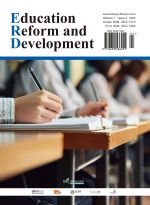Research on the Reform of Mixed Teaching of Cross-school Credit Courses
Abstract
In recent years, with the continuous advancement of education information technology, the mixed teaching mode of cross-school credit courses has come into being. It not only breaks the geographical restriction of traditional education, but also promotes the sharing and optimal allocation of educational resources [1]. Principles of Pedagogy, as the core course of pedagogy, the implementation of cross-school credits is not only an important measure to respond to the call of national education reform and promote the sharing of higher education resources, but also a key path to meet students’ personalized learning needs and improve their independent learning ability. At the same time, through the combination of online learning and offline flipped classroom, students can learn according to their own learning rhythm and points, and then comprehensively enhance their learning effect. In this regard, this paper first analyzes the background and significance of cross-school credits of the “Principles of Pedagogy” course, then clarifies the mixed teaching process of cross-school credits, analyzes the effect of teaching reform, and then puts forward feasible teaching suggestions, in order to provide some references for relevant education researchers.
References
Wang X, Li J, 2020, Research on the Innovation of Hybrid Flipped Teaching Mode of Cross-school Credit Courses from the Perspective of “Internet +”. Journal of Hubei Institute of Adult Education, 26(2): 54–62.
Cong Q, 2019, Cross-school Study Based on Educational Resource Sharing in Colleges and Universities. Journal of Huaiyin Normal University (Natural Science Edition), 19(2): 167–169 + 177.
Jiang H, Yuan L, Li Z, et al., 2021, Practice of Hybrid Teaching Mode for College Students to Study Online and Take Credit Courses Across Schools. Journal of Shenyang Agricultural University (Social Sciences Edition), 23(4): 486–490.
Huang Y, Yin N, 2022, Research on Teaching Effectiveness Improvement Strategies of Blended Teaching in Colleges and Universities: An Empirical Analysis Based on Inquiry Community Theory. Science and Education Guide, 2022(36): 22–28.
Xue M, 2019, Exploration and Reflection on the Mechanism of Cross-school Study and Credit Mutual Recognition. Journal of Taiyuan City Vocational and Technical College, 2019(6): 114–115.
Wei X, Cao J, Xiong F, 2020, Exploration on Mixed Teaching Mode of New Engineering Background. Science and Education Guide (Next Ten-day Issue), 2020(33): 11–12.
Huang M, Liu H, Chen F, et al., 2021, Exploration and Practice of Hybrid Teaching Mode in Electromechanical Transmission and Control Course. Internal Combustion Engine and Accessories, 2021(2): 253–254.
Li L, Wu L, Zou X, et al., 2019, Exploration and Application of Flipped Classroom Teaching Model in the Teaching of “Mechanical Structure Design and Assembly”. Southern Agricultural Machinery, 51(13): 149–150 + 178.
He M, 2020, Research on Cross-school Study Teaching Mode of Online and Offline Hybrid Courses. News Research Guide, 13(18): 73–75.
Shen J, Wan Y, Wang X, et al., 2022, Cross-campus Data Backup Scheme of Fudan University. China Education Network, 2022(7): 71–73.
Gao F, Pan H, Wu F, 2022, Application of Flipped Classroom Teaching Method in Cross-school Credit Courses in Outline of Modern and Modern Chinese History. Journal of Hubei Open Vocational College, 35(11): 129–130.
Chang Z, Wu J, 2022, Exploration and Practice of Cross-school Credit Teaching Model of Automobile Construction Course. China Modern Educational Equipment, 2022(3): 130–132.
Cui G, 2022, Construction of Intelligent Network Learning Space in Colleges and Universities under Cross-school Teaching Mode. Journal of Anshan Normal University, 24(4): 59–62.
Chen Y, 2022, Learning Center Teaching: How to Understand Teaching Relationship and Teacher’s Leading Role. Hubei Education (Education and Teaching), 2022(12): 34–36.
Huang Y, 2022, Research on Strategies to Promote College Students’ Learning Involvement in Blended Teaching, thesis, Guangxi Normal University.

